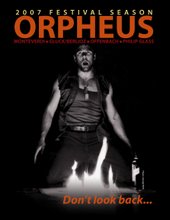
Director
Sam Helfrich explained the challenges he faces during a tech rehearsal. "I've spent three weeks in a room sitting in this one place at this one table, watching the stage from about five feet away and creating the show. The minute you move out into the house and start watching the show from 50 feet away, 100 feet away, it changes. Now it's a question of finessing things."
While looking forward to the show's opening and all the work ahead, the creative team took time last Wednesday to look back at the work they've done so far and present it to the entire staff of the opera. Orphée is based directly from French filmmaker
Jean Cocteau's film of the same name. Helfrich's first concern was translating a 1950 film with over 15 sets and effects -- such as reverse motion and people walking through mirrors --into a viable opera.
"You can't avoid--I almost regret it now-- starting out by watching the movie. It's such a beautiful and exquisite piece of filmmaking that the designers and I made the decision early on to try to find a way to approach this piece that would be theatrical, that would work on the stage and that would really have something to say that was contemporary and modern and of its time," Helfrich said.
The design team decided to create one set for the entire opera, rather than 15. It is set up like a living room--complete with walls, ceiling, and realistic furniture. It took over 5 hours to put all the pieces on stage for the first time.

Lighting was a challenge because of the shape of the set. During the seminar, nearly everyone on the creative team pointed out lighting as one of their major challenges during the tech rehearsal process.
"It should be noted that this actually is an enormously difficult set to light. It's not just because it has a ceiling. There are some limitations on what you can do from above, but we wanted to do it all using practical lighting fixtures. It's very tricky finding a balance between looking at the lighting fixtures themselves and looking at a person's face lit next to a light fixture," Andrew Lieberman, Set Designer, said.

Production Manager Matthew Kirby-Smith pointed out that the "practical lighting" is not always enough to fully light the stage. "There are lighting instrument hidden throughout backstage--over doors, in alcoves, etc. We placed lighting instruments anywhere we could to help."
Mirrors play a large structural and thematic role in the opera. To create the same atmosphere as the mirrors in the movie, each major character has a double that matches them exactly in hair, make-up, and wardrobe.
To Wig and Make-up Designer Anne Ford-Coates, the doubles presented a special challenge. "With Caroline Worra, her natural appearance makes it very easy to believe that she would have the big heart that would anchor a really temperamental artist for years. That's already there, so there wouldn't be the need to change that, except when we get to Brenda Rae, her double, who has dark hair and a different look. We have to style Caroline so she can be Eurydice, but also so that Brenda can be her for a split second on stage."

 Director Sam Helfrich explained the challenges he faces during a tech rehearsal. "I've spent three weeks in a room sitting in this one place at this one table, watching the stage from about five feet away and creating the show. The minute you move out into the house and start watching the show from 50 feet away, 100 feet away, it changes. Now it's a question of finessing things."
Director Sam Helfrich explained the challenges he faces during a tech rehearsal. "I've spent three weeks in a room sitting in this one place at this one table, watching the stage from about five feet away and creating the show. The minute you move out into the house and start watching the show from 50 feet away, 100 feet away, it changes. Now it's a question of finessing things." Lighting was a challenge because of the shape of the set. During the seminar, nearly everyone on the creative team pointed out lighting as one of their major challenges during the tech rehearsal process.
Lighting was a challenge because of the shape of the set. During the seminar, nearly everyone on the creative team pointed out lighting as one of their major challenges during the tech rehearsal process. Production Manager Matthew Kirby-Smith pointed out that the "practical lighting" is not always enough to fully light the stage. "There are lighting instrument hidden throughout backstage--over doors, in alcoves, etc. We placed lighting instruments anywhere we could to help."
Production Manager Matthew Kirby-Smith pointed out that the "practical lighting" is not always enough to fully light the stage. "There are lighting instrument hidden throughout backstage--over doors, in alcoves, etc. We placed lighting instruments anywhere we could to help."